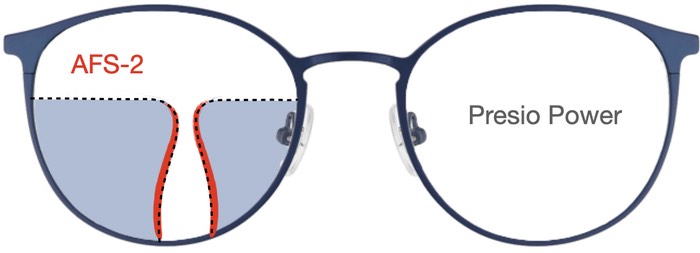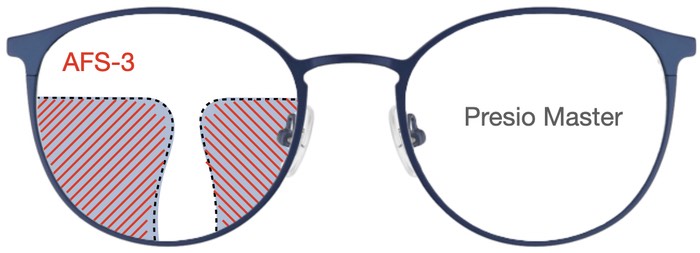In this article, we talk about the progressive lens portfolio of Nikon. Nikon has a lot of optimization ready for you to deliver wider fields of view. After you read this article you will understand what the differences are and when they will benefit you.
The name Presio in the lens line up indicates it is a progressive lens from Nikon. The name behind Presio tells you which progressive lens design we are talking about. Here below you can see a list of all progressive lenses from Nikon.
- Presio Balance
- Presio Wide
- Presio Power
- Presio Master
All progressive lens designs from Nikon have different optimizations you can order optionally with them. This is important to know because oftentimes especially those optimizations lead to an easier adaption and wider fields of view.
The reason lies in the better position for the reading area for you due to more data about how the lenses sit in the frame and in front of your eyes. In addition to this better position of the reading area technology is built into the lenses to reduce blur in the periphery and in the reading space.
However, even the best lenses still have blur on the sides. You can notice this as soon as you perform eye movements so the left and right. But let us dive a little deeper into the topic to discuss the differences.
Presio Balance
The Presio Balance is a simpler progressive lens design and often times used best when the Add value is low (Under +1.50D). The Add value describes how much reading power you need. In most cases, in the middle of your 40s, those simpler lenses work great for you. Because when the Add value is low fields of view are wider and less optimization is required for you to see optimal.

If you have a pupilar distance that is 32mm for both sides this lens is even good even if you do not use the optional optimization feature that gets called FP-Option. With this option, the optician needs to do more measurements so Nikon can calculate the best position for the reading zones in the lower half of the lenses.
This option has two stages for the optimization and they are available with every progressive lens model from Nikon:
- PD optimized
- Fully customized (More Fitting Parameters)
With the first stage, the reading area gets repositioned in correlation with the width of your pupillary distance. Depending on how wide your narrow your eyes are the whole lower part of your lenses gets customized. But the pupillar distance ist the only parameter here to optimize your visual experience.
In stage two more fitting parameters need to be given to Nikon. Such as:
- The shape of the frame
- Reading distance
- The distance between your eyes and the back surface of the lenses
- The tilt of the lenses
- The wrap angle of the lenses
With all this information Nikon can calculate with more precision where you will be looking through the lenses while reading. This is how they can manage to make the fields if view a little wider for most people.
With most manufacturers, you will not have these customization options in the lower price ranges. That is definitely a good thing. I am personally a fan of more fitting parameters. Frankly spoken the more custom progressive lenses will give you an easier and shorter time to adjust to them.
82% prefer the individual (custom) lens designs over the standard ones according to this study done by Johanne Forkel and her team. This is also what my experience tells. If you buy progressives get the more individual ones.
Nikon recommends the Presio Balance to people with an equal requirement for distance vision and the reading area. I want to make this a little clearer. In the reading area, you will have only a few millimeters for reading. So you are somehow more restricted. The distance vision is also a little more restricted compared to the following progressive lens designs.
Presio Wide
The Presio Wide has all the options and features the Presio Balance has. But the difference between them is the calculations called AFS-1 (Aberration Filter System-1). Those calculations optimize the aberrations (blur) in the upper half of the progressive lens design. This enables you to perform bigger eye movements from left to right in the upper half of the lens.
There you will find the lens power for distance vision only.

Nikon recommends this lens design for people with a demand for better vision while driving or spending time outside. This by the way does not mean all blur is gone in the upper half of the lenses. AFS-1 just optimizes your lenses.
Depending on your prescription you notice less blur compared to the Presio Balance. Especially when it comes to higher lens powers you will usually notice blur in the upper half of the lenses while performing wide eye movements from left to right.
But this happens with every lens design.
Presio Power
The Presio Power progressive lens design again has all the features described with the lens designs before. On top of everything you heard until now you get the AFS 2 optimization with this lens design. This will give you a bigger reading area compared to the progressive lens designs described before.

During the consulting for progressive lenses, it is unbelievable important your optician gives you information about what you will get to set your expectations right. If your Add (reading support) value is higher than two diopters the reading area will be quite small.
What you can expect is to see your mobile clear if you hold it in portrait mode but when you turn it into landscape mode you can see the impact of the blurry periphery.
The less price intense models already mentioned above have a progressive lens surface only on the back. The Presio Power has a progressive lens surface on the back and on the front. However the blur (surface astigmatism are still there and the differences will be little when it comes to the improvement of the width of the reading area)
The blurry periphery is the area where the next optimization stage comes into play. This stage is only available with the flag ship progressive lens design from Nikon Presio Master.
Presio Master
The Presio Master progressive lens design comes with the AFS-3 and reduces the intensity of the blur in the periphery. This gives you less wonky effects in the lower half of the lenses.

In addition to the mentioned optimized lower periphery this lens design also makes it easier for your eyes to work together. This means the blurry fields of view are optimized in a way that gives both eyes similar visual experiences although most people do not have the same lens power for both eyes.
What Is the Right Progressive Lens Design for You?
For a non professional this is really hard to tell. Because all lenses are free form lenses and basically everything sounds pretty much the same when the lenses get described.
But there are a few basic things to consider to get an answer. If you answer all questions below in the first list with yes you can get the lower-priced lenses and you will probably have a really good visual experience with them.
- Do you have lens powers below ±2 diopters?
- Is your Add value lower than or equal +1,50D?
- Is your Astigmatism lower than 1.50D?
If you answer everything with yes there is less demand for optimization features. This means the Presio Balance or the Presio Wide will be a good choice.
However, in a lot of cases, more optimization is required to further fine-tune the lenses. This way you can enjoy a shorter adaptation time and less blur in the periphery of the lenses. If you answer all the questions in the list below with yes you should go with the higher end lenses.
- Do you have lens powers higher than ±2 diopters?
- Is your Add value higher than or equal +2,00D?
- Is your Astigmatism higher than 1.50D?
What Is the Cost of Nikon Progressive Lenses?
| Progressive Lens Design: | Price starts at: |
| Presio Balance | 324€ |
| Presio Wide | 374€ |
| Presio Power | 434€ |
| Presio Master | 464€ |
That was my summary of Nikon progressive lenses.
I wish you a great day.
